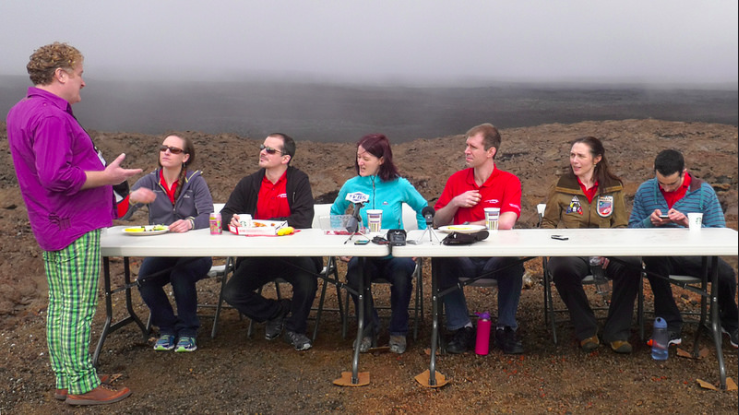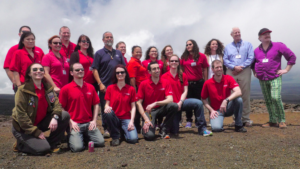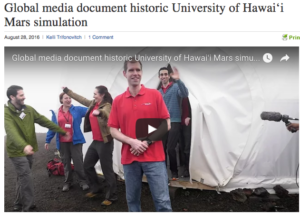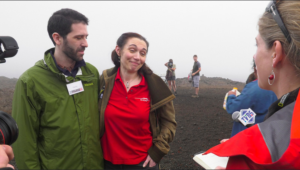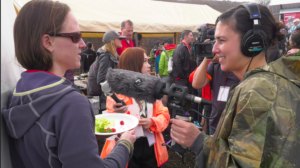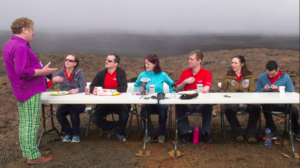Hello world! It’s been a while.
My previous post was signed, sealed, and delivered shortly before the flap on our dome’s backdoor opened and the HI-SEAS IV crew returned to Earth. At five minutes ‘till, I hit the upload key and closed my laptop for the last time on simulated Mars. Carmel was on the second floor minding the countdown clock. Andrzej was standing at his desk putting his guitar away. Most of the crew was throwing on a jacket or sweater of some kind. Reports from mission control warned that Earth – at least, the part of the planet we would be “landing” on – would be cold and foggy.
The plan that morning – August 28th, 2016 at around 9 AM Hawaii time – had been for the six of us to exit the dome in no particular order, line up, and take some photos. Our families would be nearby – waiting for the flashbulbs to die down a bit before making their approach. Exit, photos, then greet our families. That was the plan.
It went about as well as most plans do.
Two minutes until final egress, we were assembled as we had been for much of the mission: jammed into a small space with a bunch of cameras. Though nearly 366 days had elapsed since we walked into simulated Mars, never before had all of us been in the airlock at once. The two movie tripods weren’t doing much to improve the fit. And then, of course, something broke.
Space – the final frontier where stuff fails.
As the final minute rolled around, I ran down the stairs with another camera in hand, winding it on the metal pedestal and clicking it into place as a strange voice from the great beyond shouted, “Are you guys ready?”
“No!” We all said in unison.
This was the first word the Mars crew had spoken in real-time to anyone in more than a year. I was flipping on the camera and getting it in focus, “We need another minute!”
Half a Martian minute later the camera was running smoothly at the back of the teleporter. I wedged by way back in, trying not to knock it or anything else over. Safe on the far side of the exit, I looked back at the crew, “Who goes first?”
Outside, the countdown had begun in earnest. “TEN. NINE. EIGHT…”
“Carmel, you should go!”
“I’m on the end.” This was true. I was jammed on one side, towards the laundry area, and she the other, closer to the telemetry room. Andrzej and Cyprien were standing in the middle.
“..SEVEN. SIX. FIVE…”
Kim Binsted, the project PI, was responsible for opening the flap from the far side. All we had to do was walk through it and line up.
“You go first…” she looked at the folks in the middle.
“..FOUR…THREE…”
“…and when they open the flap, let’s shout, ‘Happy New Year!’”
“…TWO…”
The last thought I had before the world opened to us again was, “But it hasn’t been a year on Mars yet.”
“ONE!”
The first thought I had after the world was open to us again was, “I hope it doesn’t burn or blind us.”
The sky beyond the edge of the dome was blissfully scratch-free, in a way that it had never been when looking at it through a helmet, and gray, as if the sky had heard my wish long before I’d uttered it. I blinked twice and waited.
The now-former chief engineer ducted his head. Mars, with its tight airlocks and teeny bunks, makes everyone seem large by comparison. I had sort of forgotten how tall he was. He was certainly a lot shorter than Kim, who had unzipped the flap and was standing just beyond on the lava rock, which was redder, blacker, and sharper than I remembered, wearing a green coat. Green. Against the red, it looked like a well-watered soccer field had jumped on her shoulders. Water. There was a lot of it. A dense fog, the kind we had seen riding through the valley almost every night at sunset, swirled and curled around the solar panels like rivers of steam rising and falling in the thin mountain air.
Air.
Oxygen a glorious thing. Arriving on Mauna Loa a year and a day before, my lungs had fought what little the air carried at this altitude (8200 feet). Now, I look a thick breath of it. It smelled like my memory of the ocean. Sweet-and-sour. Briny. Cool.
Andrzej took a step. Watching him vanish between the two white flaps without a suit on was a bit surreal – like seeing someone slip out of the third dimension. Cyprien was half a step behind him. Cypi paused, framed in the dim sunlight, and raised his hand in salute. Winching up the dome flap, my eyes swept from left to the right, adjusting, searching for where my feet should plant themselves for the photos.
At the extreme right, my gaze fell upon a familiar pair of boots. It careened up the laces, scrabbled up the acrylic hiking pants with the zip-off lower legs – he ALWAYS wears those, even in bad weather – lingered momentarily on a neon-yellow raincoat that would have been right at home on a crossing guard and ground to a halt when it finally encountered, both expectedly and unexpectedly, the scruffy, bearded, smiling, beloved face of my husband.
People of Earth, I come in peace and hope the photos are everything you hoped for and more.
At some point after hugging my spouse, mother, brother, and aunt, I came to the realization that there were an awful lot of human beings on this here mountain. A lot, naturally, being any number greater than six. An awful lot being somewhere on the order of… 60? 100? It was hard to count when they wouldn’t stop milling around. The glare from the camera lenses magnified as the fog fell apart and the sun started to dominate the sky, making it even more difficult to keep an account – though, to be honest, with my right arm wrapped my husband’s waist, I only had a passing interest.
“How does it feel, Shey?”
It can be hard, so very hard, not to grin like a banshee when you’re standing on the wrong side of the camera. Nonetheless, it was a totally reasonable question and I tried to treat it as such. That the question came from a friend – a colleague, who on any given day could be sitting right beside me at an event – made it both simultaneously easier and SO MUCH more difficult not to start laughing.
Given the scene – scores of cameras, boom mics, and badges wielded by dozens of people from newspapers, film studios, tv and radio stations occupying space that had, in some sense, been space only hours before – laughter might have been fully appropriate. Briefly, I worried about whether or not we could power all this equipment, with the fog keeping the charge on our batteries low. What would we feed these people? And where would they go to the bathroom? Our composting toilet system could NOT handle this kind of load. Then I realized: I’m not on Mars anymore. I’m on Earth – which, at least in principle, has enough food, water, and latrines to go around. I looked at Nadia. According to her credentials, she was stringing for Nat Geo that day. I grabbed a handful of rocks and soil – SOIL! – took in a long, slow swig of the scent of home and said, “Nice planet you got here.”
_____________________________________
Coming back to Earth wasn’t hard. It wasn’t soft, either. In a sense, landing would have been far easier if our entry had been slowed by heat shields, parachutes, and, finally, the merciful ground itself. Instead of wrenching ourselves out of a molded plastic seat and staggering out of a smoking capsule, we walked out of a white dome under our own power, calm and steady, giving the impression that we could just keep on walking. And so we could. Later that day the commander went out for a run. My husband Ben and I hiked out to the lava flows. Six people walked in and (the same) six walked out, healthy and capable and very much in need of stopping. During the 1-year mission, no effective means of giving the crew a break had been invented. So we hadn’t really had one, nor did we get one after the mission was “over.” A few hours after our return to Earth, and many photos and a bit of food later, my mother was driving me right back to work. A life-long workaholic, Dr. Gifford Sr. surprised me by uttering, as she dropped me off at the post-mission debriefing, “Not even HALF a day off – after a YEAR? Are you kidding me?”
_________________________________
To make a long story shorter, the vacation I promised myself in the previous post hasn’t really happened – yet. To be sure, I’ve been a lot of places since that fateful, fun, weird day in late August. I’ve been to LA (twice); to New York (twice); to Chicago, Boston, Providence, Philadelphia, Raleigh-Durham, Charlestown, South Carolina and Washington, D.C. I even visited my very own home in St. Louis for a whole week before going back on the road.
Ben was able to join me for part of these travels. For most of the conferences and lectures and meetings, I’ve been on my own, surrounded by people who want to know what it was like and what it’s like to be back. Thought I would dearly like to go home – for real home to my house and husband and cats – it’s a joy to be able to share those things with my fellow humans. It was for this reason, after all, that I went to “space” and returned: to provide proof that it can be done. When I walk into a classroom or a medialab or a science Friday or a TV studio the conversation isn’t the same as it was before the mission. It’s evolved from “Can we?” to “How soon can we?” We’re no longer debating the ability, but rather the necessity and the circumstances. We’re not trembling before the challenge or grimly weighing the odds of success. We vetting the technologies and coming to grips with the sacrifices, the trade-offs, the risks and the benefits of going. It’s a good conversation to be having. It’s a thoughtful, hopeful, respectful, productive conversation to be having. It’s the kind of conversation that the world seems to be very much in of need right now. No amount of needing a vacation alters the fact that it’s an honor and a privilege to be present during these discussions, at the beginning of an era that may see humanity through to the next phase of our existence.
I called my mentor at NASA to let him know that these discussions were going on all over the country. As a result, it was going take me a while to report in down at Johnson Space Center.
Because he’s seen this before and, Universe willing, he’ll see it again, he reassured me, “You went and you came back. Now it’s your job now to tell the story.” A bit strange and strangely comforting, his reply arrived to me without a delay. He said, “The mission isn’t over.”

